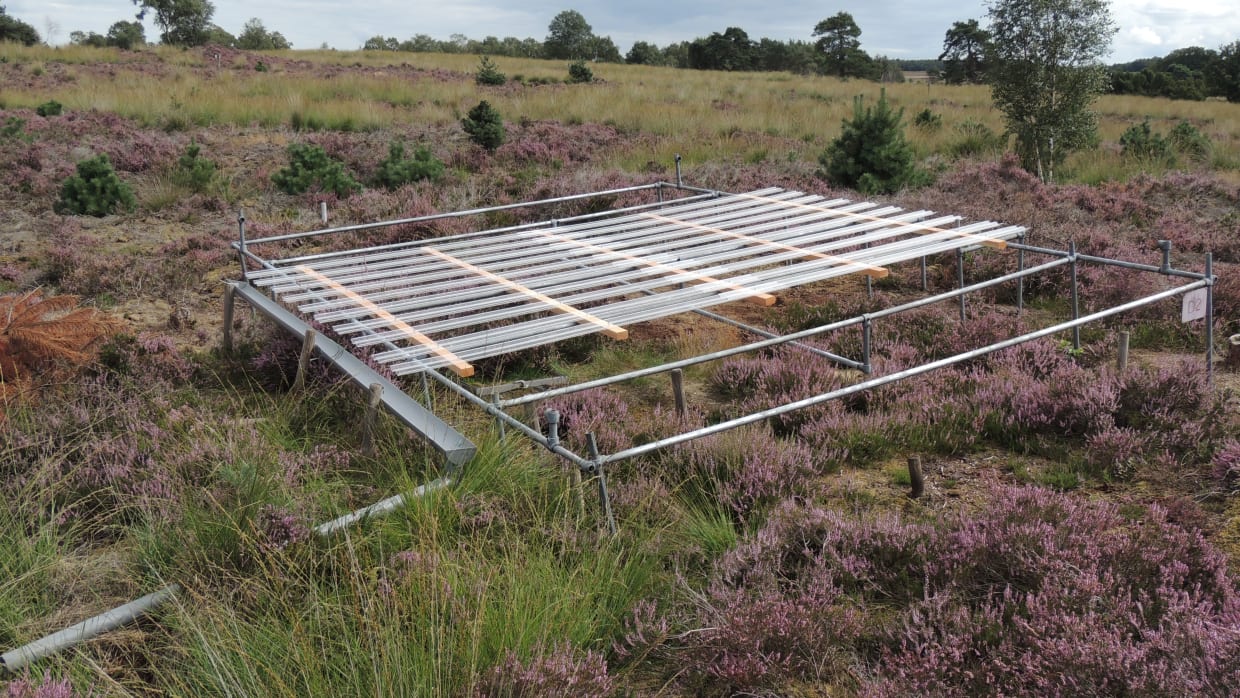
After 20 years of UvA research: “Threated by drought, heathland may lose its role as ‘carbon sink’”
For 20 years, UvA scientists studied what drought does to heathland. Mowing the heath proved to be crucial. “Drought is not only bad for plants but also for the soil, which is often forgotten.”
Every year between August and September, the Dutch heath landscape transforms into a purple patchwork of heather and scrub. Not only does this produce beautiful pictures, but the nutrient-poor soil, created by thousands of years of grazing and plowing, also provides a home for special, endangered plant and animal species on the heaths.
Increasing drought due to climate change is putting heathland under pressure. Therefore, UvA scientist Mariana Gliesch and Professor Franciska de Vries analyzed the results of a 20-year experiment on the effects of drought and soil management on a heathland landscape. They published the results in the Journal of Applied Ecology in late April. Gliesch says: “Drought not only negatively affects the growth of certain plants, but also their interactions with the soil. Often the subsurface role of plants is forgotten in research and management.”

Carbon sink
Soil is important because it stores most of the world’s carbon. When that carbon is released as CO2, it contributes to climate change. “Since plants interact with microbial communities such as bacteria and fungi, they indirectly cause carbon to be stored underground,” Gliesch explained. “This is because carbon from the atmosphere is sequestered not only in the biomass of plants, their roots, and stem or stems but also through the plants by underground microbes. So microbes are crucial for soil carbon storage. Drought threatens to deprive heathland of its role as a ‘carbon sink.’”
To investigate the effects of drought on soil, a drought experiment was set up in 1998. On the heathland landscape on the grounds of the Royal Netherlands Army near Oldebroek, the researchers created a drought situation in several places with transparent corrugated sheets that automatically moved over the planting when it rained. “Within the field of ecology, this is a well-known experimental set-up,” Gliesch explains. “In this way, we could manipulate drought and investigate the response to drought of the soil under heathland plants at different growth stages. To create different growth stages, we used different mowing periods.”
Heathland management
The researchers had expected drought to reduce soil carbon storage among young heathland plants - subject to 10-year mowing cycles - and grasses. “The underlying idea was that young heathland plants would behave like grasses that are primarily geared toward rapid growth and invest less energy in strong plant structures and underground interaction with bacteria and fungi. It turned out to be a little different,” laughs Gliesch. “While drought has negative effects on underground carbon storage, this is particularly true below ground in older heathland plants and grasses. In the soil samples in younger heathland plants, we saw that the presence of bacteria and fungi was much higher, leading to a reduced loss in carbon storage due to drought.”
Based on these results, the researchers stress that adapted heathland management is necessary to preserve the heathland landscape. Gliesch continues: “Our results show the importance of mowing, preferably once every 10 years. This promotes a landscape dominated by younger heather plants and helps to reduce the loss of soil carbon in future climate scenarios. In this way, grasses, which grow more easily due to nitrogen deposition, also have less of a chance. The active management of heathlands is thus not only essential for maintaining above-ground biodiversity but also makes it more resilient to a changing climate due to increasing droughts.”

